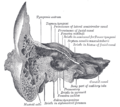Facial canal
Facial canal is a bony structure found in the temporal bone of the skull, which houses and protects the facial nerve (CN VII) as it traverses through the skull. The facial canal is crucial for the protection and function of the facial nerve, which is responsible for controlling the muscles of facial expression, conveying taste sensations from the anterior two-thirds of the tongue, and supplying secretomotor fibers to the lacrimal, submandibular, and sublingual glands.
Anatomy[edit]
The facial canal begins at the internal acoustic meatus, a passage in the temporal bone, and ends at the stylomastoid foramen, through which the facial nerve exits the skull. The canal can be divided into three segments: the labyrinthine segment, the tympanic segment, and the mastoid segment.
Labyrinthine Segment[edit]
The labyrinthine segment, also known as the meatal segment, is the shortest and narrowest part of the facial canal. It begins at the fundus of the internal acoustic meatus and extends to the geniculate ganglion, a swelling in the nerve that contains cell bodies of sensory neurons.
Tympanic Segment[edit]
The tympanic segment runs laterally from the geniculate ganglion, above the oval window (an opening in the bone surrounding the cochlea), and continues behind the tympanic cavity. This segment is important as it is where the nerve makes a sharp bend, known as the first genu.
Mastoid Segment[edit]
The mastoid segment is the longest part of the facial canal. It extends from the second genu, located at the posterior wall of the tympanic cavity, and descends vertically to exit the skull through the stylomastoid foramen. This segment of the canal also gives off a small branch known as the chorda tympani, which carries taste fibers from the anterior two-thirds of the tongue and secretomotor fibers to the submandibular and sublingual glands.
Clinical Significance[edit]
Damage to the facial nerve at any point along the facial canal can result in facial nerve palsy, which is characterized by weakness or paralysis of the muscles of facial expression on the affected side. Causes of facial nerve damage include Bell's palsy, infections, tumors, and trauma. Diagnosis often involves imaging studies such as MRI or CT scans to visualize the facial canal and identify any abnormalities.
Treatment[edit]
Treatment of facial nerve palsy depends on the underlying cause. Corticosteroids are commonly used to reduce inflammation in cases of Bell's palsy. Surgical intervention may be necessary to relieve pressure on the nerve in cases of trauma or to remove tumors.
See Also[edit]
-
Facial canal
-
Dissection of the occipital bone
-
Facial canal
Ad. Transform your life with W8MD's Budget GLP-1 injections from $75


W8MD offers a medical weight loss program to lose weight in Philadelphia. Our physician-supervised medical weight loss provides:
- Weight loss injections in NYC (generic and brand names):
- Zepbound / Mounjaro, Wegovy / Ozempic, Saxenda
- Most insurances accepted or discounted self-pay rates. We will obtain insurance prior authorizations if needed.
- Generic GLP1 weight loss injections from $75 for the starting dose.
- Also offer prescription weight loss medications including Phentermine, Qsymia, Diethylpropion, Contrave etc.
NYC weight loss doctor appointmentsNYC weight loss doctor appointments
Start your NYC weight loss journey today at our NYC medical weight loss and Philadelphia medical weight loss clinics.
- Call 718-946-5500 to lose weight in NYC or for medical weight loss in Philadelphia 215-676-2334.
- Tags:NYC medical weight loss, Philadelphia lose weight Zepbound NYC, Budget GLP1 weight loss injections, Wegovy Philadelphia, Wegovy NYC, Philadelphia medical weight loss, Brookly weight loss and Wegovy NYC
|
WikiMD's Wellness Encyclopedia |
| Let Food Be Thy Medicine Medicine Thy Food - Hippocrates |
Medical Disclaimer: WikiMD is not a substitute for professional medical advice. The information on WikiMD is provided as an information resource only, may be incorrect, outdated or misleading, and is not to be used or relied on for any diagnostic or treatment purposes. Please consult your health care provider before making any healthcare decisions or for guidance about a specific medical condition. WikiMD expressly disclaims responsibility, and shall have no liability, for any damages, loss, injury, or liability whatsoever suffered as a result of your reliance on the information contained in this site. By visiting this site you agree to the foregoing terms and conditions, which may from time to time be changed or supplemented by WikiMD. If you do not agree to the foregoing terms and conditions, you should not enter or use this site. See full disclaimer.
Credits:Most images are courtesy of Wikimedia commons, and templates, categories Wikipedia, licensed under CC BY SA or similar.
Translate this page: - East Asian
中文,
日本,
한국어,
South Asian
हिन्दी,
தமிழ்,
తెలుగు,
Urdu,
ಕನ್ನಡ,
Southeast Asian
Indonesian,
Vietnamese,
Thai,
မြန်မာဘာသာ,
বাংলা
European
español,
Deutsch,
français,
Greek,
português do Brasil,
polski,
română,
русский,
Nederlands,
norsk,
svenska,
suomi,
Italian
Middle Eastern & African
عربى,
Turkish,
Persian,
Hebrew,
Afrikaans,
isiZulu,
Kiswahili,
Other
Bulgarian,
Hungarian,
Czech,
Swedish,
മലയാളം,
मराठी,
ਪੰਜਾਬੀ,
ગુજરાતી,
Portuguese,
Ukrainian


